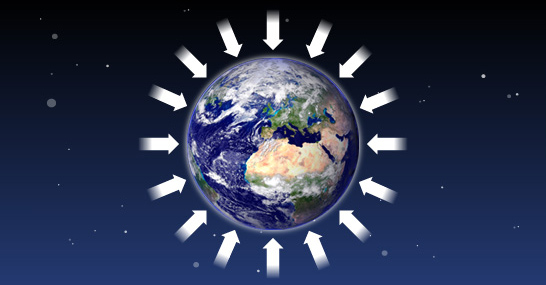How big is the Earth?

The planet Earth is very special and unique in its own way. It is the only celestial body that has the specific proportion of raw materials and appropriate gaseous atmosphere to sustain life in all forms. It consists of all the natural resources essential for life to survive and propagate. And this is why the earth harbours such a huge diversity of life forms, across all terrains and living environments.
With so many qualities to it, it will be interesting to learn a little more about how big our Earth actually is.
Contents
The Earth
The third planet in the Solar System, Earth is the only planet to date where life exists. This celestial body is mainly divided into three parts of surface equivalent in water, and only one part equivalent to solid land.
Furthermore, this one-fourth of the land is divided into 7 landmasses, also called continents. The seven continents are Asia, Africa, Europe, North America, South America, Australia and Antarctica.
The most popular inhabited of these is Asia, which includes nearly two-thirds of people living in the entire world.
How big is the Earth?
The Earth is sphere-shaped (also known as the globe). According to this shape, it is understandable that its widest
point is just in the middle.
This portion of the Earth demarcating its centre is actually represented by an imaginary line called the Equator. Though it is not physically present on the surface of the Earth, it is very useful in referring to different parts of the world. The Equator however divides the entire Earth into two equal parts or hemispheres. These are the Northern Hemisphere and Southern Hemisphere.
Now, if one supposedly tried to walk along the equator, it would approximately take the person a year to cover the entire distance or width of 24,901 miles (40,075 km).
Continents And Oceans
From the one-third portion of land in the world, there emerged 7 huge fragmented landmasses called the continents. These 7 continents (as listed above) are further bifurcated into countries. Just like the continents, these countries too are not of uniform sizes.
The remaining spaces between the continents are filled up by nearly three-quarters of deepwater called the Ocean. These waters are open except for the portions that are bordering any country (where they are guarded by security rules of that particular country).
The water of the earth is divided into five main areas/oceans. These are Pacific, Atlantic, Indian, Arctic, and Southern Antarctic Oceans.
Fun Facts
- The parts of the Earth that lie just next to each side of the equator, are known as the tropics.
- The shape of the earth is not a perfect sphere, since the top and bottom part of it appears a little smashed!
Related questions
- What is the variation in temperature in the Tropics?
- What are the Tropics of Cancer and Capricorn?
- How does the rotation of the earth affect seasonal changes?
Fill in the Blanks
- The Earth is diametrically divided into two ______.
- ________ is the imaginary line running in the middle of the Earth.
- There are ____ continents and ________ oceans in the world.
- ________ has no countries.
- ________ is the most populous continent.
True Or False
- Earth is the fifth planet of the solar system: ________
- The width of the earth is its largest distance: ________
- The Tropics lie near the poles of the Earth: _______
- Equator is an imaginary line: ________
- Oceans are shallow areas of water: _______






Responses